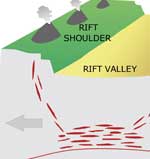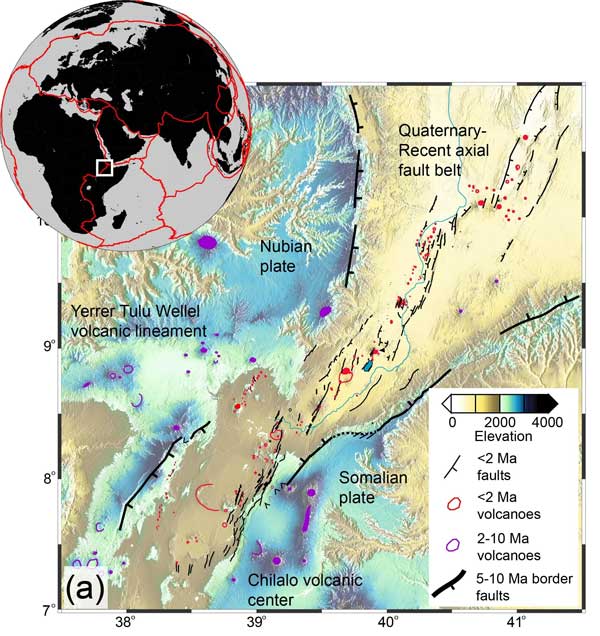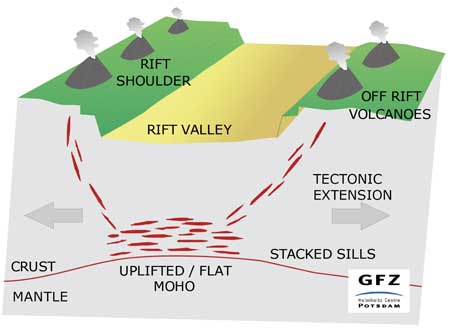 |
Rift-induced gravitational unloading:
A mechanism for the formation of off-rift volcanoes in continental rift zones |
Francesco Maccaferri1, Eleonora Rivalta1, Derek Keir2, Valerio Acocella3
1GeoForschungsZentrum Potsdam, Section 2.1, Helmholtzstrasse 7, 14467, Potsdam, Germany; francesco.maccaferri@gfz.potsdam.de ; eleonora.rivalta@gfz-potsdam.de
2National Oceanography Centre Southampton, University of Southampton, Southampton, SO14 3ZH, UK; D.Keir@soton.ac.uk
3Dipartimento Scienze, University of Roma Tre, L. S.L. Murialdo, 1, 00146, Roma, Italy; valerio.acocella@uniroma3.it
This webpage is a summary of: Maccaferri, Francesco, Eleonora Rivalta, Derek Keir and Valerio Acocella, Off-rift volcanism in rift zones determined by crustal unloading, Nature Geoscience, 7, 297-300, 2014, doi:10.1038/ngeo2110
Introduction
Rift valleys are the surface expression of prolonged extension in the continents. During rift initiation, the lithosphere thins by ductile stretching and normal faulting, creating a rift valley [1]. The upwelling asthenosphere melts by adiabatic decompression, with the greatest degree of partial melting beneath the most thinned part of the crust [2,3]. Melt can accumulate at the brittle-ductile transition, in magmatic reservoirs centred on the rift axis. Crustal stretching and melt production beneath the rift axis often result in the formation of volcanoes within the rift valley, as observed, for instance, in the Northern Volcanic Zone of Iceland. A common observation near continental rift zones is the occurrence of off-rift volcanism [4,5,6,7], i.e. volcanoes located up to tens of kilometers outside of the rift valley (Figure 1). Off-rift volcanoes and off-rift volcanic provinces are generally aligned parallel to the rift axis and often associated with early rifting [4,5]. In the Red Sea Rift ~25 Ma-old rift-parallel dykes are concentrated near the ~30 Ma rift margins, while the youngest volcanoes are concentrated along the ridge axis [8]. Even in settings that are far less magmatically active, such as the Baikal Rift (Siberia) or the Chaine des Puys (CdP) in the Cenozoic rift system of France, off-rift volcanism occurred after the onset of rifting [6,7]. The mechanism driving magma from deep, rift-centred magma reservoirs to feed off-rift volcanic systems is debated.

Figure 1: Topographic, structural and volcanic architecture of the Main Ethiopian Rift. Miocene border faults are thick black lines with direction of down-throw indicated. The Quaternary-Recent faults within the rift are shown as thin black lines. Early syn-rift volcanic edifices are purple and Quaternary-Recent volcanoes and cones are red. The early syn-rift volcanism ranges from being located just outboard of the Miocene border faults, to as far as 100 km from the rift valley.
Methodology
We used a numerical (boundary element) model to simulate the propagation of magmatic dykes [9,10,11] starting from a deep magmatic reservoir located at the base of the crust, centred on the rift axis. Our model gives as output the expected location of volcanism at the surface, as well as the path followed by dykes before being arrested within the crust or arriving at surface.
A fundamental input into our model is the stress field within the crust, since dykes tend to orient perpendicular to the direction of minimum compressive stress (σ3). We model the stress field accounting for:
-
lithostatic pressure;
-
tectonic stress; and
-
the mechanical effect of gravitational unloading (decompression) induced by the mass deficit at the rift valley.
The resulting stress field in the crust is the superposition of 1, 2 and 3, where 1 is assumed to be isotropic and therefore does not contribute to the orientation of the principal stresses; 2 is the horizontal tension due to crustal stretching, assumed to be in the range 5 - 10 MPa, and to favour a horizontal orientation of σ3; and 3 can be computed using analytical formulas [12].
Results
The contribution of gravitational unloading is the essential component in our study. When gravitational unloading dominates over tectonic stretching, σ3 becomes vertical in a confined volume beneath the rift. This volume constitutes a sort of “stress barrier zone” in which stacked sills are favoured, and which deflects the ascending dykes to the sides of the rift. On either side of the rift centre, σ3 becomes first inward-dipping and then horizontal (Figure 2).

Figure 2: Dyke trajectories for scenarios a, b and c (explained below). Red squares indicate the upper tip of the dyke at injection, red circles indicate that a dyke has been arrested as sill, and red triangles indicate the position of the arrival at surface. Black and gray segments show the directions of σ1 and σ3 respectively (a circle indicates direction perpendicular to the page) for three nominal sets of graben widths, W, and depths, D (see insets). The dip angle of σ3 is color-shaded: where sub-vertical (reddish), a stress barrier to vertical ascent of dykes acts. The stress barrier is expected to dissipate in a weak lower crust or mantle. Click here or on Figure for enlargement.
Depending on where the dykes nucleate relative to the stress-barrier zone, there are three scenarios for their propagation and for the final surface distribution of magmatism:
-
If dykes start above the stress barrier (or if the stress barrier is below the crust), within-rift volcanism occurs. Dykes ascend subvertically, or propagate laterally within the rift parallel to its axis (Figure 2a), and dyke-fed volcanism is distributed within the graben.
-
If dykes start within the stress barrier (or the stress barrier extends across the crust and up to the brittle-ductile transition), our model predicts off-rift volcanism with sill formation. The injected magma at the base of the crust forms sub-horizontal magmatic sheets that, depending on their initial distance from the rift axis, are either trapped as stacked sills above the ponding zone or escape to the sides of the stress barrier. From there they turn into subvertical dykes and eventually reach the surface (Figure 2b). For a given set of parameters, dykes emerge very tightly spaced at a distance from the rift axis equal to about 1 - 2 (and up to 3) graben half-widths.
-
If a dyke starts beneath the stress barrier, off-rift volcanism occurs without sill formation. Vertical dykes are deflected towards the rift sides and produce a more scattered arrival distribution at the surface (Figure 2c). This occurs with deep nucleation below shallow and narrow grabens. This is the least frequent scenario for a reasonable range of values for graben depths and widths and crustal thicknesses.
Discussion & Conclusions
For deep grabens the upper limit of the stress barrier (z1) is shallow (z1 ~ 10 km for a 100-km-wide and 1-km-deep graben) so that in-rift dyke-arrivals occur only for shallow nucleation depths. For a nucleation depths in the range 30 - 40 km, which represents a reasonable estimate for crustal thickness at the early stage of continental rifting, in-rift volcanism occurs only for wide (> 100 km) and shallow (< 0.6 km) rift depressions, or for grabens too shallow to create a stress barrier (i.e. tectonic stretching dominates over gravitational unloading). A thinner crust or shallower reservoirs favour “in-rift volcanism”, as expected for the Northern Volcanic Zone of Iceland or for Quaternary volcanism in the Main Ethiopian Rift.
The most frequent configuration for the early stages of continental rifting is scenario b. This results in the construction of large off-rift volcanoes distributed parallel to the rift. Also, for this scenario, our model predicts that magmatic intrusions will easily be trapped as stacked sills beneath the rift axis, above the Moho (Figure 2b and Figure 3). Recent results from seismic tomography at Baikal rift suggest that a deep, rift-centred reservoir at Moho depths formed from stacked sills [13].

Figure 3: Cartoon illustrating the magma paths leading to off-rift volcanism. (Graphics by Regina Milkereit.)
As the rift matures, the magma-ponding zone near the base of the crust becomes progressively shallower due to crustal thinning and to sills piling one above the other and functioning as new, shallower reservoirs. This drives the system towards the condition of case a, and to transition to in-rift volcanism.
Earlier models considered flexure of the lithosphere and interaction of magma with large boundary faults to explain rift-flank volcanism [5]. Boundary faults certainly influence magma ascent in the upper crust. However, our models suggest that if unloading stresses are ignored, dykes from a ponding zone beneath the rift, ascending in a stress field associated with normal faults, always reach the surface within the graben. The flexural behaviour of the crust may add local variations in the stress pattern, but these are not expected to alter the overall distribution of stresses [5].
References
-
McKenzie, D. Some remarks on the development of sedimentary basins. Earth Planet. Sci. Lett., 40, 25-32 (1978).
-
Lubimova, E.A. Heat flow patterns from Baikal and other rift zones. Tectonophysics, 8, 457-467 (1969).
-
Bown, J.W. & White, R.S. Effect of finite extension rate on melt generation at rifted continental margins. J. Geophys. Res., 100, 18011-18029 (1995).
-
Ellis, M. & King, G. Structural control of flank volcanism in continental rifts. Science, 254, 839-842 (1991).
-
Morton, W.H., Mitchell, J.G., Rex, D.C. & Mohr, P. Riftward younging of volcanic units in the Addis-Ababa region, Ethiopian rift valley. Nature, 280, 284-288 (1979).
-
Kiselev, A I. Volcanism of the Baikal rift zone. Tectonophysics, 143, 235-244 (1987).
-
Richet, P. Guide des Volcans de France, BRGM Belin, Paris (2003).
-
Bosworth, W., Huchon, P. & McClay, K. The Red Sea and Gulf of Aden Basins. J. African Earth Sci., 43, 334-378 (2005).
-
Dahm, T. Numerical simulations of the propagation path and the arrest of fluid-filled fractures in the Earth. Geophys. J. Int., 141, 623-638 (2000).
-
Maccaferri, F., Bonafede, M. & Rivalta, E. A numerical model of dike propagation in layered elastic media. Geophys. J. Int., 180, 1107-1123 (2010)
-
Maccaferri, F., Bonafede, M. & Rivalta, E. A quantitative study of the mechanisms governing dike propagation, dike arrest and sill formation. J. Volcanol. Geotherm. Res., 208, 39-50 (2011).
-
Davis, R. & Selvadurai, A. Elasticity and Geomechanics, Cambridge Univ. Press, Cambridge (1996).
-
Thybo, H. & Nielsen, C.A. Magma-compensated crustlal thinning in continental rift zones. Nature, 457, 873-876 (2009).
last updated 7th
June, 2014 |
